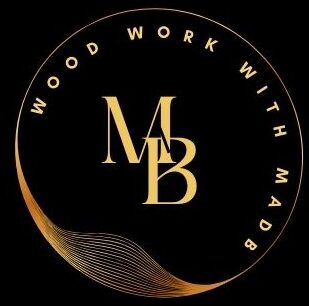What is woodturning?
Woodturning is a specialised form of woodworking where a lathe machine is used to shape and carve wooden objects. The process involves rotating a piece of wood while cutting tools (such as chisels and gouges) are applied to shape it.
Woodturning offers a fantastic opportunity to create both practical and decorative items using your skills. Woodturning allows you to create various functional and decorative items, including bowls, vases, furniture legs, and more.
Types of Wood Suitable for Turning:
- Walnut: A hardwood with a beautiful grain pattern, creamy white colour, and moderate ease of workability. It’s great for various projects.
- Ash: Used for baseball bats, ash ranks between maple and cherry in hardness. It’s relatively easy to turn.
- Maple: A classic dark brown hardwood suitable for various turning projects.
- Chestnut: A light-coloured softwood that can be turned with ease.
- Cypress: A softwood with a distinct grain pattern, often used for outdoor projects.
- Hickory: Hardwood with strength and durability, but it can be challenging to turn.
- Pine: Softwood that’s easy to work with but less durable.
- Cherry: A popular hardwood with a reddish-brown colour, suitable for turning.

Woodturning Machines:
- Mini Lathes: Compact and great for beginners. Examples include the Rikon 70-105 Mini Lathe and the Delta Industrial Midi Lathe.
- Midi Lathes: More powerful than mini lathes, suitable for intermediate turners. Examples include the PSI Woodworking Turncrafter Commander Midi Lathe and the Shop Fox W1758 Wood Lathe.
- Full-Size Lathes: Larger and more robust, ideal for professional woodturners. The JET JWL-1015VS Variable-Speed Wood Lathe is a good choice.
Reviews of Wood Lathes:
- Rikon 70-105 Mini Lathe: Great for pen makers due to its compact size and ease of use.
- Delta Industrial Midi Lathe: Powerful and versatile, suitable for both beginners and intermediate turners.
- PSI Woodworking Turncrafter Commander Midi Lathe: Offers good value for money and decent performance.
- Shop Fox 8in x 13in Benchtop Wood MINI Lathe, W1704 Power Tools: Sturdy and reliable, suitable for larger projects.
- SIP 12in x 36in Variable Speed Wood Lathe: Powerful mini lathe with variable speed control.
Tools Needed for Woodturning:
- Lathe: The central machine for woodturning.
- Chisels and Gouges: Essential cutting tools for shaping wood.
- Callipers: Used for measuring diameters accurately.
- Tool Rest: Supports the tools during turning.
- Spur Drive and Live Center: Hold the workpiece securely.
- Outside Calipers: Measure diameters.
- Wood Stock: Choose squared stock for leaving pommels (square areas) on the finished piece.
- Safety Gear: Eye protection, dust mask, and hearing protection.
Turning a Table Leg Example:
- Rough out the blank and measure dimensions based on a manufactured leg.
- Turn the foot, cove, sphere, and taper using different tools.
- Mark the blank for key details and diameters.
- Size diameters accurately.
- Repeat the same shape for all legs.
- Sand and finish the leg.
Finishing techniques
Finishing techniques are essential for enhancing the appearance, durability, and protection of woodturning projects.
Let’s explore some common methods:
- Sanding:
- Sanding is crucial to achieve a smooth surface. Start with coarse-grit sandpaper (around 80-120 grit) and gradually move to finer grits (up to 400 or higher).
- Sand along the grain to avoid scratches.
- Remove any tool marks, irregularities, and tear-outs.
- Sealing and Priming:
- Apply a wood sealer or sanding sealer to fill pores and prevent stain absorption.
- Use a shellac-based primer for better adhesion of paint or other finishes.
- Staining:
- Stains enhance the wood’s colour and grain pattern.
- Apply oil-based or water-based stains using a brush or cloth.
- Wipe off excess stains after a few minutes.
- Oil Finishes:
- Danish oil, tung oil, and linseed oil are popular choices.
- Apply multiple coats, allowing each coat to dry thoroughly.
- These finishes provide a natural look and feel.
- Wax Finishes:
- Apply a paste wax (such as beeswax) to create a soft sheen.
- Buff the surface with a soft cloth for a smooth finish.
- Polyurethane Varnish:
- Provides excellent protection.
- Apply thin coats using a brush or spray.
- Sand lightly between coats for better adhesion.
- Friction Polishing:
- Commonly used for small items like pens.
- Rub a cloth with wax (such as carnauba wax) against the spinning wood.
- The friction generates heat, melting the wax and creating a glossy finish.
- Ebonizing:
- Create a black finish by applying a solution of vinegar and steel wool to the wood.
- The tannins in the wood react with the iron in the solution.
- Painting:
- For decorative pieces, consider painting with acrylics or other wood-safe paints.
- Sand lightly between coats for a smooth finish.
- Buffing and Polishing:
- Use a buffing wheel with polishing compounds (such as Tripoli or white diamond) to achieve a high-gloss finish.
- Buffing can be done with wax or without it.
Remember to test any finish on a scrap piece before applying it to your project. Each wood species may react differently to various finishes. Enjoy experimenting and finding the perfect finish for your woodturning creations!





